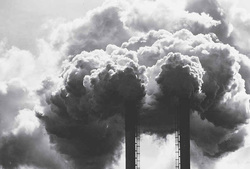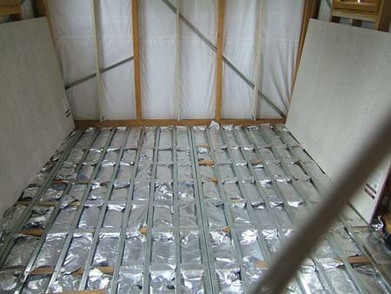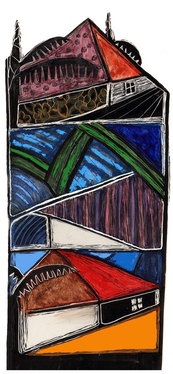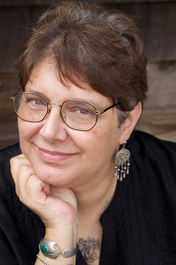
The story of my body is the story of the planet, and I need your help to tell it.
My name is Aurora Levins Morales. I have spent my writing career drawing connections between the intimate and the global, between the struggles of my own life as a chronically ill, Caribbean born, Jewish, woman of color artist and single mother, the struggles of humans everywhere, and the endangered planetary web of life. I tell stories, mostly through the medium of writing, but also through visual art, public speaking, and performance— stories that reveal difficult truths, but above all, foster hope, and an expanded sense of possibility, connection, and adventure.
My writing reaches people in ways that purely informational articles can’t. I make the critical issues of our time into personal stories that enter the heart as well as the mind, and lead to engagement and change. My stories are crafted from my own experience, from my deep and broad knowledge of world history, my profound sense of ecology, and from listening to a wide variety of people, and weaving their tales into my own. I bring my personal truth to the big questions we face as a species: how will we live with one another, with the rest of life, with the finite waters, forests, air? How will we share the precious necessities, take care of each other, resolve conflicts? How will we end war and heal the traumatized, and stop the corporate plundering that underlies so many of our ills? The story of my body really is the story of the planet. As I travel around this country and others in my tiny house, I will be talking about human health as a measure of planetary health, about deforestation and malaria, the stress of endless struggles and diabetes, global warming and chronic inflammation, small scale farming and the preservation of soil, epilepsy and organophosphate pesticides invented hand in hand with military nerve gas.
My name is Aurora Levins Morales. I have spent my writing career drawing connections between the intimate and the global, between the struggles of my own life as a chronically ill, Caribbean born, Jewish, woman of color artist and single mother, the struggles of humans everywhere, and the endangered planetary web of life. I tell stories, mostly through the medium of writing, but also through visual art, public speaking, and performance— stories that reveal difficult truths, but above all, foster hope, and an expanded sense of possibility, connection, and adventure.
My writing reaches people in ways that purely informational articles can’t. I make the critical issues of our time into personal stories that enter the heart as well as the mind, and lead to engagement and change. My stories are crafted from my own experience, from my deep and broad knowledge of world history, my profound sense of ecology, and from listening to a wide variety of people, and weaving their tales into my own. I bring my personal truth to the big questions we face as a species: how will we live with one another, with the rest of life, with the finite waters, forests, air? How will we share the precious necessities, take care of each other, resolve conflicts? How will we end war and heal the traumatized, and stop the corporate plundering that underlies so many of our ills? The story of my body really is the story of the planet. As I travel around this country and others in my tiny house, I will be talking about human health as a measure of planetary health, about deforestation and malaria, the stress of endless struggles and diabetes, global warming and chronic inflammation, small scale farming and the preservation of soil, epilepsy and organophosphate pesticides invented hand in hand with military nerve gas.
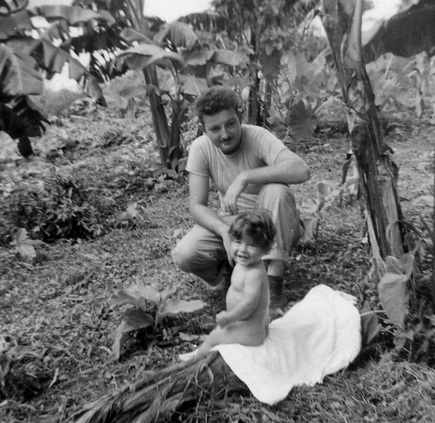
I was born on a coffee farm in 1954, in the age of “better living through chemistry,” with a liver that couldn’t handle the job of clearing pesticides from my blood. Dieldrin, which is linked to the cancer that killed my mother, is used to give lab rats epilepsy for research purposes. Parathion, used against mosquitoes, can also "kindle" seizures. I started having partial seizures as a child and full blown "grand mal" seizures as a young adult. I live with chronic muscle and joint pain, spasms, and exhaustion, and have unpredictable and often severe reactions to medications, household cleaning products, shampoos, laundry detergents, adhesives and many other common substances. I've had multiple head injuries from seizure falls, and in 2007 I had a stroke. One of my doctors told me that the pesticide powders that clung to my father's clothing when he picked me up are probably still lodged in my body, while stress hormones--from sexual violence, migration, racism, sexism, single parenting on too little money, fear of my own government, fear of war, fear of losing health coverage--wear away at my tissues, unbalance my endocrine system, and keep my body in a state of red alert.
Reckless industrial development in the name of profit and progress has wounded our landscapes and our bodies. Violence engendered by greed rips at our families, communities, hearts. I am sick from the same toxins that have sickened millions of people, tens of thousands of other species, and are sickening the planet.
I am also entranced by urban gardens filled with organic tomatoes of medicinal teas, inspired by the revolt of fast food workers demanding a living wage, nourished by the constitutional right to health care of Cubans, Venezuelans, Ecuadoreans, elated at the return of indigenous lands in Bolivia and the melting down of captured Venezuelan guns into beams to build houses for the poor. My story is not just a cry of alarm. It's a story about hope, about commitment, about people with the courage to try things, about people who stand up for each other, share what they have, reach for something better for all of us, a different version of human nature.
The Vehicle for Change is my story incubator, both a sanctuary and a laboratory, a way to heal my body, calm my spirit and focus my creativity and conviction where it will have the greatest impact.
Reckless industrial development in the name of profit and progress has wounded our landscapes and our bodies. Violence engendered by greed rips at our families, communities, hearts. I am sick from the same toxins that have sickened millions of people, tens of thousands of other species, and are sickening the planet.
I am also entranced by urban gardens filled with organic tomatoes of medicinal teas, inspired by the revolt of fast food workers demanding a living wage, nourished by the constitutional right to health care of Cubans, Venezuelans, Ecuadoreans, elated at the return of indigenous lands in Bolivia and the melting down of captured Venezuelan guns into beams to build houses for the poor. My story is not just a cry of alarm. It's a story about hope, about commitment, about people with the courage to try things, about people who stand up for each other, share what they have, reach for something better for all of us, a different version of human nature.
The Vehicle for Change is my story incubator, both a sanctuary and a laboratory, a way to heal my body, calm my spirit and focus my creativity and conviction where it will have the greatest impact.
